Marketing attribution models serve the same purpose as instant replays in sports—to help marketers determine which touchpoints contribute to the winning outcome.
Every customer interaction could lead to a sale, but accurately attributing success to the right touchpoint optimizes your marketing strategy and budget. Discover the six popular attribution models empowering you to make data-driven decisions, enhance campaign effectiveness, and ultimately increase your return on investment (ROI)
- What is attribution modeling—from first to multi-touch
- Mastering marketing attribution: 6 models to know
- 3 factors to consider when choosing the right attribution model
What is attribution modeling—from single to multi-touch
Marketing attribution models are frameworks for analyzing which touchpoints or marketing channels are responsible for driving conversions. Attribution models let businesses allocate credit to specific marketing efforts. By identifying which marketing touchpoints were most effective, brands can tap into key benefits.
- Improved ROI tracking: Understanding which channels and campaigns drive conversions helps you allocate budgets more effectively to maximize returns.
- Enhanced customer journeys: Learning how different touchpoints contribute to the final conversions enables you to optimize each stage of the journey, ensuring a seamless and more effective path to purchase.
- Data-driven decision-making: Insights into the performance of various marketing activities ensure that decisions are based on actual performance metrics rather than assumptions, leading to more strategic and impactful marketing initiatives.
- Optimized marketing mix: Precise attribution data identifies the most effective combination of channels and tactics, reducing wasteful spending and improving marketing effort efficiency.
The two primary types of attribution models are single-touch and multi-touch. Choosing the model that suits your brand depends on your business goals and the complexity of your customer journey.
Single-touch models—such as first-click and last-click attribution—assign all conversion credit to one touchpoint in the customer journey.
Multi-touch models—such as linear, time decay, and position-based attribution—distribute credit across multiple interactions.
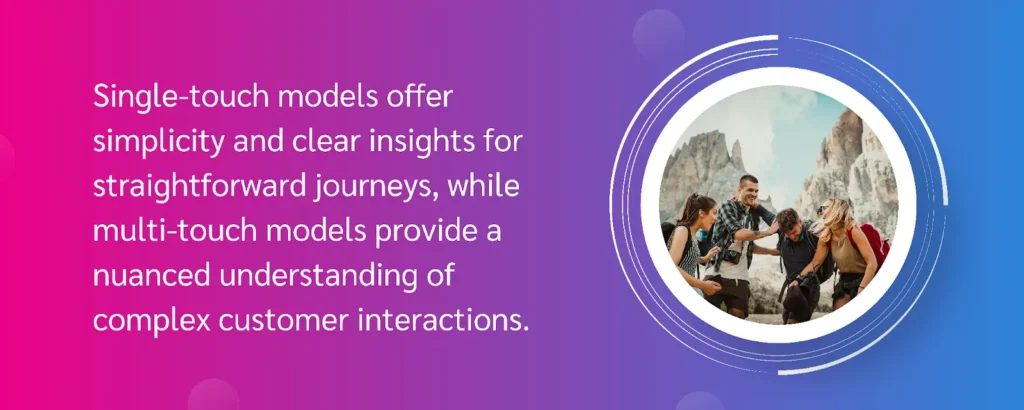
Mastering marketing attribution: 6 models to know
The six main attribution models have advantages and limitations. From first-click to algorithmic attribution, each method offers unique insights into how different interactions influence conversions.
Understanding the options available helps you make an informed decision about choosing the right attribution model for your business.
1. First-click attribution: Crediting the initial spark
First-click attribution gives the entire credit for a conversion to the first interaction a customer has with your brand before converting.
For example, a customer first discovers an online shoe store through an Instagram ad and browses the website. A week later, they return directly to the site and make a purchase. The Instagram ad receives full credit for the sale because it was the first interaction that introduced the customer to the store.
First-click models work well for businesses aiming to measure awareness and customer acquisition campaigns with well-defined entry points, including specific ad campaigns or targeted content marketing efforts.
Benefits:
✅ Brand discovery insights: Identifies how customers first discover your brand and the effective channels driving top-of-funnel activities.
✅ Simplicity and clarity: Easy to understand and implement, providing clear insights without complex analysis.
Limitations:
❌ Neglects subsequent interactions: Ignores the influence of other touchpoints after the initial interaction, potentially undervaluing other marketing efforts that contribute to the conversion.
❌ Incomplete journey insights: Provide an unclear picture of customer behavior and the overall journey for businesses with longer and more complex sales cycles.

2. Last-click attribution: Rewarding the deal closer
Last-click attribution assigns all the credit for a conversion to the final interaction before a customer purchases.
For example, a B2B lead attends a webinar, reads several blog posts, and finally fills out a lead form after clicking on a LinkedIn retargeting ad. The LinkedIn retargeting ad is attributed to generating the lead because it was the final interaction that led to filling out the form.
Last-click attribution works well for companies with shorter sales cycles where the final interaction significantly influences the conversion.
Benefits:
✅ Conversion optimization: Shows which touchpoint drives the final purchase decision, helping to pinpoint high-performing channels at the lower end of the funnel.
✅ Simplicity and ease of implementation: Straightforward to understand and implement without complex data analysis.
Limitations:
❌ Ignores pre-conversion journey: Overlooks earlier interactions, potentially underappreciating the cumulative impact of multichannel marketing efforts.
❌ Narrow perspective: Provides a skewed view of channel effectiveness for businesses with long sales cycles or multiple touchpoints
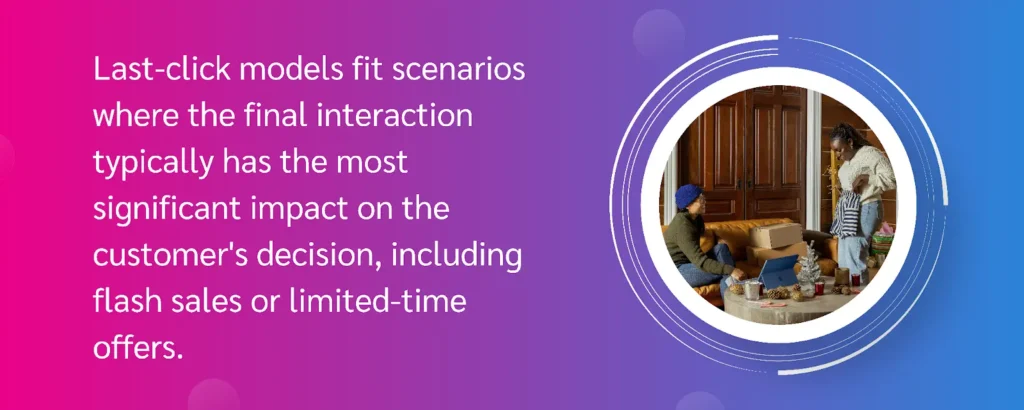
3. Linear attribution: Sharing equal credit for all
Linear attribution distributes the credit for a conversion equally across all touchpoints the customer encounters throughout the buying journey.
For example, a user discovers your app through a YouTube influencer review, engages with your social media posts, and clicks on a targeted ad before downloading the app. Each touchpoint receives an equal share of the credit for the app download and recognizes the shared impact on the user’s journey.
Linear attribution works well for long sales cycles involving numerous interactions, such as in B2B sectors. It’s ideal for multichannel campaigns where no single touchpoint dominates the customer journey, and each interaction progressively influences the final conversion.
Benefits:
✅ Holistic view of the customer journey: Recognizes the importance of all touchpoints and promotes resource allocation across the customer journey.
✅ Fair evaluation of channels: Every channel involved in the customer journey receives recognition so marketers can see the cumulative effect of their efforts.
Limitations:
❌ Oversimplification: Equal distribution of credit oversimplifies individual touchpoints’ unique impacts–not all interactions have the same influence on conversions.
❌ Less insight into critical touchpoints: Limits the ability to identify particularly high-performing channels or stages.
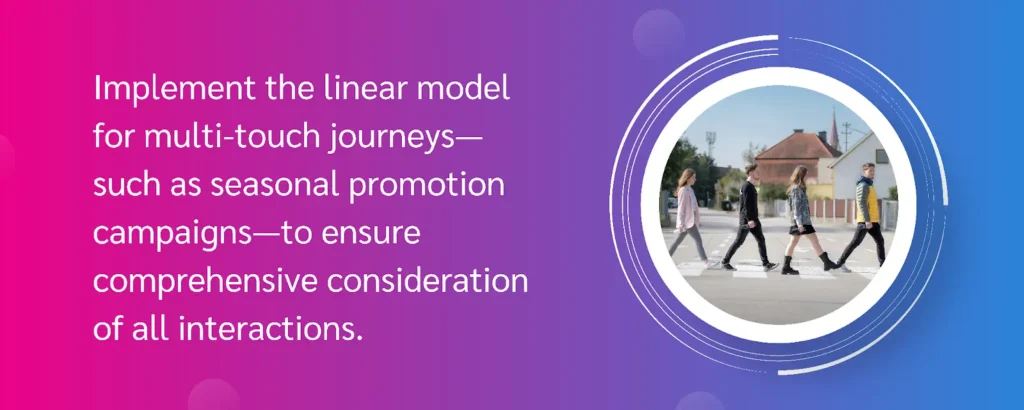
4. Position-based attribution: Recognizing key moments
Position-based or U-shaped attribution allocates 40 percent of the credit each to the first and last interactions and distributes the remaining 20 percent among the middle touchpoints.
For example, An individual learns about your online course through a LinkedIn article (40%), listens to a relevant podcast episode (20%), and enrolls after clicking on a paid search ad (40%).
This model is ideal for businesses with mid-length sales cycles, where the initial engagement and the final touchpoint are crucial, and intermediary steps also play a notable role.
Benefits:
✅ Balanced emphasis: Acknowledges the significance of initial and final touchpoints without undervaluing middle interactions.
✅ Comprehensive view: Provides a more nuanced perspective of the entire customer journey, recognizing that multiple interactions contribute to the final decision.
Limitations:
❌ Fixed distribution issue: Static credit percentages may not fit all journeys.
❌ Complex to implement: Requires detailed customer interaction data, which may be complicated to track and analyze.
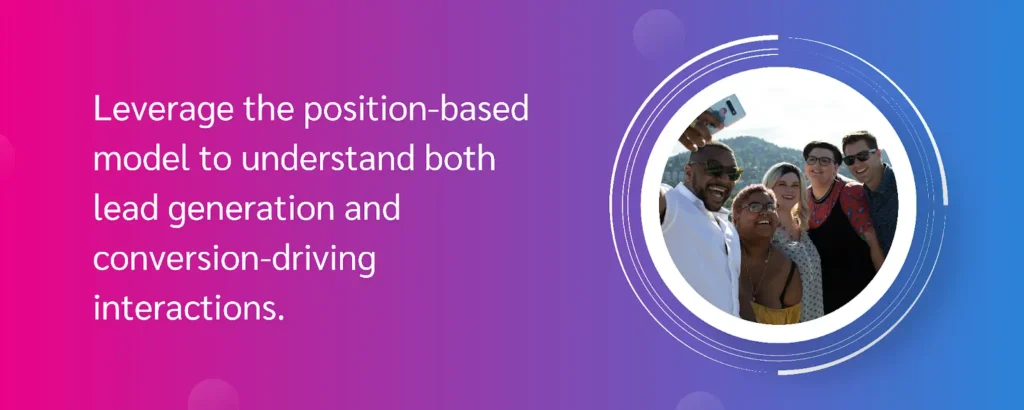
5. Time decay attribution: Acknowledging recent actions
Time decay attribution assigns increasing credit to touchpoints as they approach the conversion moment.
For example, a traveler finds your travel agency via a blog post (20%), reads customer reviews (30%), and books a vacation package after clicking on a remarketing email (50%).
This model suits sectors such as online retail with extended customer journeys where the final touchpoints significantly impact the conversion decision.
Benefits:
✅ Recent influence: Emphasizes the impact of recent interactions, providing a more realistic view of how last-minute touchpoints affect conversions.
✅ Adaptive to customer behavior: Reflects typical customer decision-making processes, where recent engagements are more likely to drive the final conversion. This makes it particularly useful for high-consideration purchases and retargeting campaigns.
Limitations:
❌ Potential undervaluation of early touchpoints: Underestimates the impact of earlier interactions that initially engaged the customer or raised awareness.
❌ Complexity in implementation: Requires sophisticated tracking systems and algorithms to accurately weigh the timing of each interaction, which is challenging to manage.
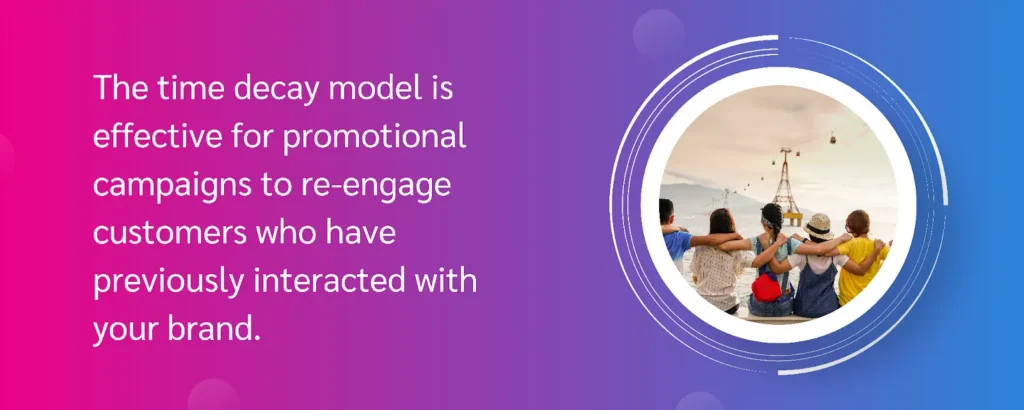
6. Algorithmic attribution: Using data-driven, AI precision
Algorithmic attribution uses machine learning and statistical algorithms to assign conversion credit across all touchpoints based on their quantified influence on the customer’s decision to purchase.
For example, a potential SaaS subscriber engages with a blog post (20%), a case study (25%), a webinar (20%) and then subscribes after clicking a retargeting ad (35%).
Algorithmic attribution benefits organizations with access to large datasets and the resources to handle sophisticated analytics, such as tech companies and large e-commerce platforms
Benefits:
✅ Data-driven precision: Offers a high level of accuracy by analyzing large datasets and identifying complex relationships between touchpoints and conversions
✅ Customization and adaptability: Tailors attributions to specific business needs, adjusting the contribution weight based on unique customer behaviors and marketing configurations
Limitations:
❌ Complexity: Requires significant data input and advanced analytics capabilities, making it resource-intensive. This can potentially be expensive for small businesses.
❌ Transparency: Acts as a black box, making it challenging to understand how decisions are made and explain the results to stakeholders.
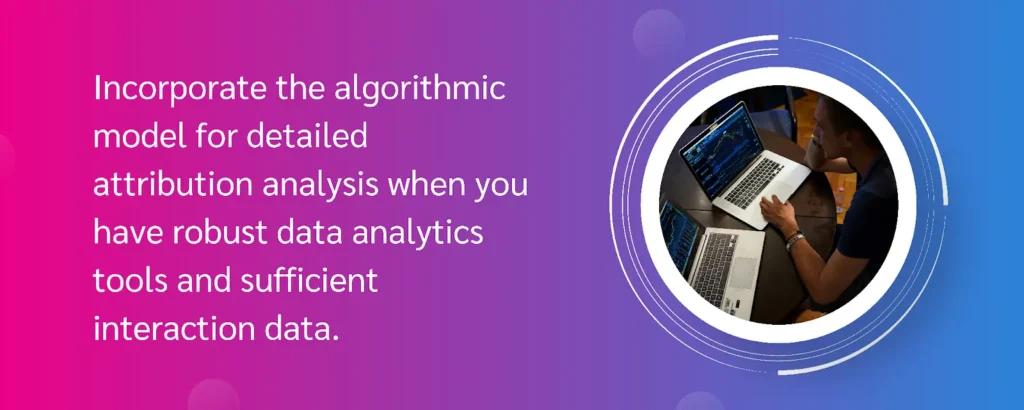
3 factors to consider when choosing the right attribution model
Selecting the best model involves carefully considering several factors, including the complexity of the customer journey, addressing privacy regulations hindering data collection, and accounting for cross-device interactions.
However, leveraging the right tools can help you navigate these challenges and make informed decisions about your attribution strategy.
1. Complexity of the customer journey
The modern customer journey is often non-linear, involving multiple touchpoints across various channels. This complexity can make it challenging to assign credit for conversions accurately.
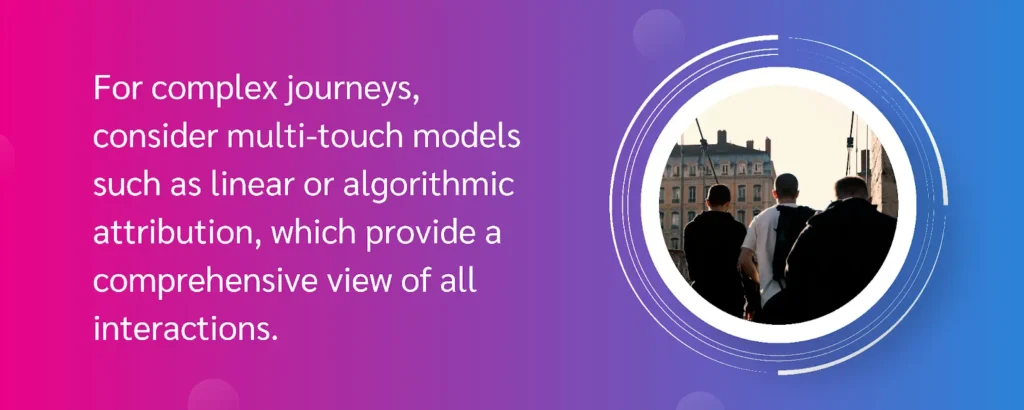
Understanding the entirety of the customer journey is crucial for precise attribution. So, using advanced analytics tools maps out the entire conversion path. Robust reports, such as impact.com’s Contribution Report and Funnel Report, detail how each touchpoint contributes to conversions, allowing for a more accurate attribution.
2. Privacy regulations
Google Chrome’s decision to phase out third-party cookies highlights a shift toward a cookieless future. Privacy regulations, such as GDPR and CCPA, also tighten the reins on data collection. These regulations protect user privacy and complicate the ability to track user behavior comprehensively.
Management platforms, such as impact.com, have built-in tracking solutions that comply with evolving regulations. For instance, with browsers clamping down on cookie-based tracking, the impact.com platform provides excellent ITP-compliant alternatives like the Universal Tracking Tag [UTT].
Since the UTT sets cookies in a first-party context, they remain unaffected. Placing the UTT across your site gives you the most comprehensive tracking information about the consumer journey, direct traffic, conversion paths, etc.
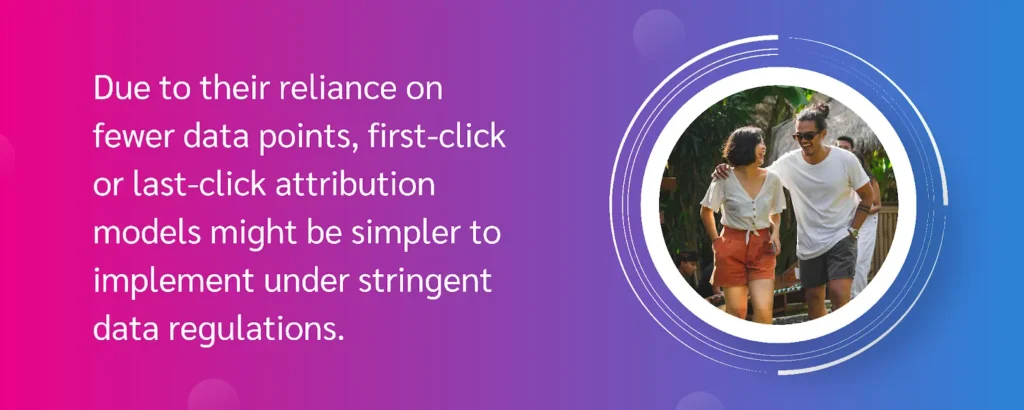
3. Cross-device interactions
Consumers often research on one device and convert on another, making tracking and attributing accurately challenging. If you only see customer touchpoints on the converting device, you’ll miss essential context.
Employing cross-device tracking capabilities helps understand how users interact with your brand across different devices. Brands can link devices belonging to the same user and see how partners interact along the path to purchase alongside other channels.
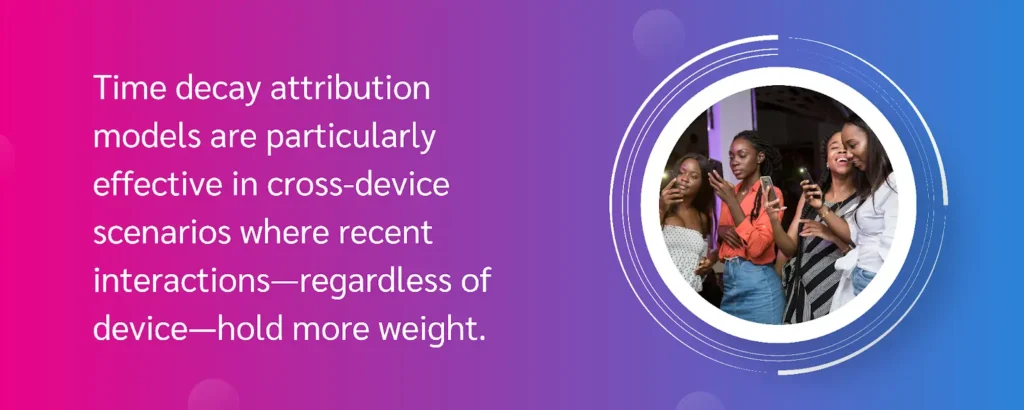
Marketing attribution FAQ
Attribution models highlight which marketing efforts are driving sales or conversions. They help marketers understand which channels (such as social media, email, or ads) are most effective in getting customers to take action. By analyzing this data, businesses can make better decisions on where to spend their marketing budget.
Single-touch attribution models, such as first-click and last-click, assign all credit for a conversion to one interaction. Multi-touch models, on the other hand, distribute credit across multiple touchpoints. This comprehensive approach offers a more detailed picture of how interactions contribute to the final sale.
First-click attribution: Credits the customer’s first interaction with your brand for the entire conversion.
Last-click attribution: Assigns all credit to the final interaction before a purchase.
Linear attribution: Distributes credit equally across all touchpoints in the customer journey.
Position-based attribution (U-shaped): Allocates 40% credit to both the first and last interactions, with the remaining 20% distributed among the middle touchpoints.
Time decay attribution: Assigns increasing credit to touchpoints as they get closer to the conversion moment.
Algorithmic attribution: Uses machine learning to assign credit based on the quantified impact of each touchpoint.
Maximize your marketing impact with accurate attribution models
Selecting the right attribution model is pivotal for accurately gauging your marketing efforts and understanding customer behavior. Each model—from first-click to algorithmic—offers unique insights that can help tailor your strategy. The ideal choice depends on your industry, the complexity of your sales cycle, and the marketing channels you utilize. By experimenting with different models, you can discover which one best aligns with your business needs and optimizes your marketing ROI.




